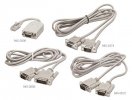Hi, FreeBSD Gurus!
Looking for proper cable for Graceful / Safe Shutdown of server:
So from one side of cable there must be are RJ11, and the DB9 on opposite end. But I do not know the pinout.
2.
Which daemon / port / package best to solving my problem ?
And sub-question: is NUT better than apccups in my case with cable connection?
So, the question is what is proper pinout cable and software for Graceful / Safe Shutdown of FreeBSD server?
(is it null-modem with full handshaking or with half-handshaking?...)
UPDATE
Unfortunately, I cannot able to find ANY information regarding that RJ11 connector in ANY user manuals/tech docs on that particular PDU, legacy and newest PDUs from that company.... Spending around 4h of total screen time
But I asking here because have a tough that in nowadays that may be something standardized, like this, because most of hardware solutions made from “other OEM blocks”.
P.S.
I have a little bit equipment in a lab, two hands and not stupid (I hope) head, so I able to doing cable myself.
Looking for proper cable for Graceful / Safe Shutdown of server:
So from one side of cable there must be are RJ11, and the DB9 on opposite end. But I do not know the pinout.
2.
Which daemon / port / package best to solving my problem ?
And sub-question: is NUT better than apccups in my case with cable connection?
So, the question is what is proper pinout cable and software for Graceful / Safe Shutdown of FreeBSD server?
(is it null-modem with full handshaking or with half-handshaking?...)
UPDATE
Unfortunately, I cannot able to find ANY information regarding that RJ11 connector in ANY user manuals/tech docs on that particular PDU, legacy and newest PDUs from that company.... Spending around 4h of total screen time
But I asking here because have a tough that in nowadays that may be something standardized, like this, because most of hardware solutions made from “other OEM blocks”.
P.S.
I have a little bit equipment in a lab, two hands and not stupid (I hope) head, so I able to doing cable myself.


